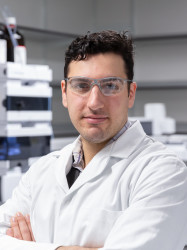Current Research
The Solar Coatings Group work on a range of solar-state materials that can harvest sunlight to drive a wide range of chemical processes for solar fuels production and remediating the environment
The chemical processes studied include:
- the conversion of H2O into O2 and clean H2 fuel
- the conversion of CO2 waste streams into carbon-based products/ feedstocks (including syngas, HCOOH, CH4, etc.)
- the conversion of NOx pollution in city air into benign products (including NO3- or N2)
- the removal of heavy metal arsenic from water
- the disinfection of surfaces and contaminated water streams, removing bacteria and viruses
The Solar Coatings Group use various strategies to study, develop and prototype solar-state materials
Our strategies include:
- the use of in operando spectroscopies for the time-resolved study of reaction kinetics and mechanisms, which are used to inform the development of rational materials design strategies
- the development of scalable materials synthesis strategies and their optimisation to enhance material functionality, which includes the use of combinatorial materials synthesis, high-throughput physical and functional characterisation and machine learning methods to more rapidly identify promising materials and their optimisation
- the scale up of promising materials syntheses for the production of prototypes at scales commensurate to their desired commercial application, and the implementation of technoeconomic and life-cycle analyses to inform improved prototype design
The Solar Coatings Group collaborates with various research groups across Imperial College London, the UK and internationally to conduct cutting edge research in the use of sunlight to drive chemical conversions
Our collaborators include:
- The Durrant Group and Bakulin Group - for time-resolved spectroscopi studies of reaction kinetics and mechanisms
- The Stephens Group - for studies on the electrochemical conversion of H2O
- The Hankin Group - for the testing of large-scale (~100 cm2) photoelectrochemical prototypes
- The Nelson Group - modelling photoelectrochemical device performance
- The Walsh Group and Ganose Group - for the use of machine learning tools to identify relationships from the big data generated in our combinatorial research
- The Harrison Group - for the use of computation to study the electronic interactions found at the interfaces in our solid-state structures
- The Myers Group - for the fabrication of prototype building materials that incorporate our solid-state catalysts and use of technoeconomic and life-cycle analyses to inform improved design
- The Sotelo Vázquez Group at the Universidad Rey Juan Carlos - for disinfection testing of surfaces and contaminated water streams
- The Sathasivam Group at London South Bank University - for combinatorial studies of transparent electrode materials

